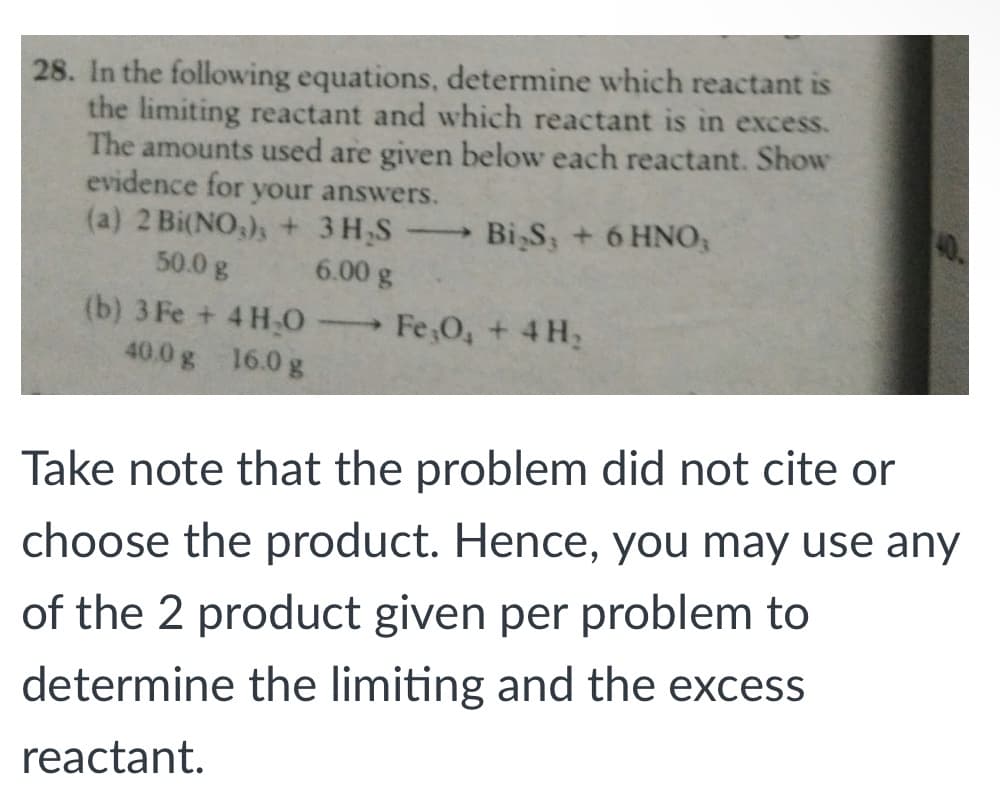8. In the following equations, determine which reactant is the limiting reactant and which reactant is in excess. The amounts used are given below each reactant. Show evidence for your answers. (a) 2 Bi(NO,), + 3H,S Bi¸S; + 6 HNO, 50.0 g 6.00 g (b) 3 Fe + 4 H;0 Fe,O, + 4 H: 40.0 g 16.0 g
8. In the following equations, determine which reactant is the limiting reactant and which reactant is in excess. The amounts used are given below each reactant. Show evidence for your answers. (a) 2 Bi(NO,), + 3H,S Bi¸S; + 6 HNO, 50.0 g 6.00 g (b) 3 Fe + 4 H;0 Fe,O, + 4 H: 40.0 g 16.0 g
Introductory Chemistry: A Foundation
9th Edition
ISBN:9781337399425
Author:Steven S. Zumdahl, Donald J. DeCoste
Publisher:Steven S. Zumdahl, Donald J. DeCoste
Chapter6: Chemical Reactions: An Introduction
Section: Chapter Questions
Problem 68AP
Related questions
Question

Transcribed Image Text:28. In the following equations, determine which reactant is
the limiting reactant and which reactant is in excess.
The amounts used are given below each reactant. Show
evidence for your answers.
(a) 2 Bi(NO,), + 3 H,S
50.0 g
Bi,S; + 6 HNO,
40%
6.00 g
(b) 3 Fe + 4 H0
Fe 0, + 4 H2
40.0 g 16.0 g
Take note that the problem did not cite or
choose the product. Hence, you may use any
of the 2 product given per problem to
determine the limiting and the excess
reactant.
![V [ Choose ]
Water is the limiting
reactant and iron is in
excess
Iron is the limiting reactant
and water is in excess
Bismuth (III) nitrate is the
limiting reactant and
hydrogen sulfide is in
excess
Hydrogen sulfide is the
limiting reactant and
Bismuth (II) nitrate is in
excess](/v2/_next/image?url=https%3A%2F%2Fcontent.bartleby.com%2Fqna-images%2Fquestion%2F42124286-d4b3-4bdf-a838-27e1391fea4b%2Fb269ba0f-ce1d-4b04-aff2-410c8928bdbf%2F6yi4p86_processed.jpeg&w=3840&q=75)
Transcribed Image Text:V [ Choose ]
Water is the limiting
reactant and iron is in
excess
Iron is the limiting reactant
and water is in excess
Bismuth (III) nitrate is the
limiting reactant and
hydrogen sulfide is in
excess
Hydrogen sulfide is the
limiting reactant and
Bismuth (II) nitrate is in
excess
Expert Solution
This question has been solved!
Explore an expertly crafted, step-by-step solution for a thorough understanding of key concepts.
This is a popular solution!
Trending now
This is a popular solution!
Step by step
Solved in 3 steps

Knowledge Booster
Learn more about
Need a deep-dive on the concept behind this application? Look no further. Learn more about this topic, chemistry and related others by exploring similar questions and additional content below.Recommended textbooks for you

Introductory Chemistry: A Foundation
Chemistry
ISBN:
9781337399425
Author:
Steven S. Zumdahl, Donald J. DeCoste
Publisher:
Cengage Learning

Chemistry by OpenStax (2015-05-04)
Chemistry
ISBN:
9781938168390
Author:
Klaus Theopold, Richard H Langley, Paul Flowers, William R. Robinson, Mark Blaser
Publisher:
OpenStax

Chemistry & Chemical Reactivity
Chemistry
ISBN:
9781337399074
Author:
John C. Kotz, Paul M. Treichel, John Townsend, David Treichel
Publisher:
Cengage Learning

Introductory Chemistry: A Foundation
Chemistry
ISBN:
9781337399425
Author:
Steven S. Zumdahl, Donald J. DeCoste
Publisher:
Cengage Learning

Chemistry by OpenStax (2015-05-04)
Chemistry
ISBN:
9781938168390
Author:
Klaus Theopold, Richard H Langley, Paul Flowers, William R. Robinson, Mark Blaser
Publisher:
OpenStax

Chemistry & Chemical Reactivity
Chemistry
ISBN:
9781337399074
Author:
John C. Kotz, Paul M. Treichel, John Townsend, David Treichel
Publisher:
Cengage Learning

Chemistry & Chemical Reactivity
Chemistry
ISBN:
9781133949640
Author:
John C. Kotz, Paul M. Treichel, John Townsend, David Treichel
Publisher:
Cengage Learning

Chemistry for Engineering Students
Chemistry
ISBN:
9781337398909
Author:
Lawrence S. Brown, Tom Holme
Publisher:
Cengage Learning

Chemistry: Principles and Reactions
Chemistry
ISBN:
9781305079373
Author:
William L. Masterton, Cecile N. Hurley
Publisher:
Cengage Learning